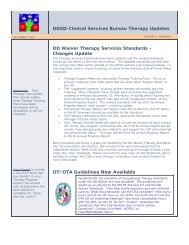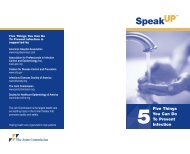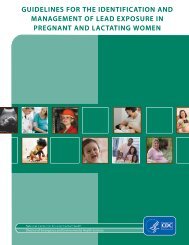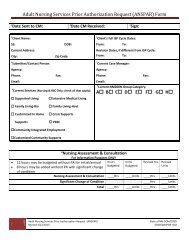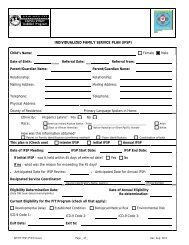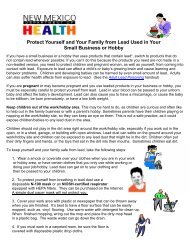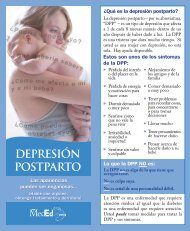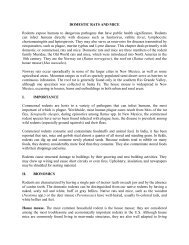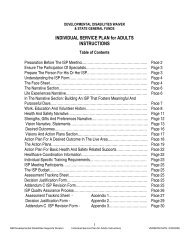Medical Countermeasure Dispensing - Centers for Disease Control ...
Medical Countermeasure Dispensing - Centers for Disease Control ...
Medical Countermeasure Dispensing - Centers for Disease Control ...
Create successful ePaper yourself
Turn your PDF publications into a flip-book with our unique Google optimized e-Paper software.
CAPABILITY 8: <strong>Medical</strong> <strong>Countermeasure</strong> <strong>Dispensing</strong><br />
<strong>Medical</strong> countermeasure dispensing is the ability to provide medical countermeasures<br />
(including vaccines, antiviral drugs, antibiotics, antitoxin, etc.) in support of treatment<br />
or prophylaxis (oral or vaccination) to the identified population in accordance with<br />
public health guidelines and/or recommendations.<br />
This capability consists of the ability to per<strong>for</strong>m the following functions:<br />
Function 1: Identify and initiate medical countermeasure dispensing strategies<br />
Function 2: Receive medical countermeasures<br />
Function 3: Activate dispensing modalities<br />
Function 4: Dispense medical countermeasures to identified population<br />
Function 5: Report adverse events<br />
Function 1: Identify and initiate medical countermeasure dispensing strategies<br />
Notify and coordinate with partners to identify roles and responsibilities consistent with the identified agent or exposure and<br />
within a time frame appropriate to the incident.<br />
Tasks<br />
This function consists of the ability to per<strong>for</strong>m the following tasks:<br />
Task 1: Prior to an incident, and if applicable during an incident, engage subject matter experts (e.g., epidemiology, laboratory,<br />
radiological, chemical, and biological) including federal partners, to determine what medical countermeasures are<br />
best suited and available <strong>for</strong> the incidents most likely to occur based on jurisdictional risk assessment. (For additional<br />
or supporting detail, see Capability 12: Public Health Laboratory Testing and Capability 13: Public Health Surveillance and<br />
Epidemiological Investigation)<br />
Task 2: Prior to an incident, and if applicable during an incident, engage private sector, local, state, regional, and federal partners,<br />
as appropriate to the incident, to identify and fill required response roles (For additional or supporting detail, see Capability<br />
3: Emergency Operations Coordination and Capability 15: Volunteer Management)<br />
Per<strong>for</strong>mance Measure(s)<br />
At present there are no CDC-defined per<strong>for</strong>mance measures <strong>for</strong> this function.<br />
Resource Elements<br />
Note: Jurisdictions must have or have access to the resource elements designated as Priority.<br />
PLANNING (P)<br />
P1: (Priority) Written plans should include standard operating procedures that provide guidance to identify the medical<br />
countermeasures required <strong>for</strong> the incident or potential incident. Consideration should be given to the following<br />
elements:<br />
– Number and location of people affected by the incident, including a process to collect and analyze medical and<br />
social demographic in<strong>for</strong>mation of the jurisdiction’s population to plan <strong>for</strong> the types of medications, durable<br />
medical equipment, or consumable medical supplies that may need to be provided during an incident, including<br />
supplies needed <strong>for</strong> the functional needs of at-risk individuals. 106<br />
– Agent or cause of the incident<br />
(For additional or supporting detail, see Capability 12: Public Health Laboratory Testing)<br />
– Severity of the incident<br />
– Potential medical countermeasures<br />
(For additional or supporting detail, see Capability 13: Public Health Surveillance and Epidemiological Investigation)<br />
– Time line <strong>for</strong> establishing medical countermeasure dispensing operations<br />
– Personnel and staffing mix<br />
Suggested resources<br />
– CDC Emergency Preparedness and Response: http://emergency.cdc.gov<br />
U.S. Department of Health and Human Services<br />
<strong>Centers</strong> <strong>for</strong> <strong>Disease</strong> <strong>Control</strong> and Prevention<br />
Public Health Preparedness Capabilities:<br />
National Standards <strong>for</strong> State and Local Planning<br />
71
CAPABILITY 8: <strong>Medical</strong> <strong>Countermeasure</strong> <strong>Dispensing</strong><br />
Function 1: Identify and initiate medical countermeasure dispensing strategies<br />
Resource Elements (continued)<br />
– Federal Emergency Management Agency National Response Framework Incident Annexes:<br />
http://www.fema.gov/emergency/nrf/incidentannexes.htm<br />
– Radiation Emergency <strong>Medical</strong> Management website:<br />
http://www.remm.nlm.gov<br />
– CDC Radiation Emergency website (medical countermeasures):<br />
http://emergency.cdc.gov/radiation/countermeasures.asp<br />
– Management of Persons Contaminated with Radionuclides Handbook:<br />
http://www.ncrponline.org/Publications/161press.html<br />
– <strong>Medical</strong> Management of Radiological Casualties Handbook, Second Edition:<br />
http://www.afrri.usuhs.mil/www/outreach/pdf/2edmmrchandbook.pdf<br />
– Conference of Radiation <strong>Control</strong> Program Directors: www.crcpd.org<br />
PLANNING (P)<br />
P2: Written plans should be developed by jurisdictional level, multidisciplinary planning groups who meet on a regular basis<br />
and contain representatives who would respond during a public health or emergency incident. 107,108 Planning group<br />
members could include the following constituencies:<br />
– Public health departments<br />
– Jurisdictional Emergency Management/Office of Homeland Security<br />
– Law en<strong>for</strong>cement<br />
– Private businesses (including pharmacies)<br />
– Emergency medical services (both public and private)<br />
– Hospitals and clinics<br />
– <strong>Medical</strong> professional organizations<br />
– Military installations<br />
– Metropolitan <strong>Medical</strong> Response System participants<br />
– Volunteer groups (e.g., Red Cross and Salvation Army)<br />
– Radiation-specific group, (e.g., Radiation <strong>Control</strong> Programs, U.S. Environmental Protection Agency, or State<br />
Environmental Agency). (The Conference of Radiation <strong>Control</strong> Program Directors provides a list of state radiation<br />
control programs at http://www.crcpd.org/Map/RCPmap.html)<br />
– Private organizations such as retailers with supply chains and package delivery services (e.g., U.S. Postal Service,<br />
UPS, FedEx, and DHL)<br />
– U.S. Department of Health and Human Services Regional Emergency Coordinators<br />
SKILLS AND TRAINING (S)<br />
Group will meet on a regular basis to review the medical countermeasures plans and ensure participants understand<br />
their roles and responsibilities. Evidence of the meetings include the following elements:<br />
– Defined roles and responsibilities<br />
– Sign off agreement of the protocols<br />
(For additional or supporting detail, see Capability 1: Community Preparedness and Capability 3: Emergency Operations<br />
Coordination)<br />
S1: Staff participating in dispensing operations should understand jurisdictional medical countermeasure dispensing<br />
requirements, plans, and procedures.<br />
– CDC Emergency Use Authorization Online Course: http://emergency.cdc.gov/training/eua/index.html<br />
– Receiving, Distributing, and <strong>Dispensing</strong> Strategic National Stockpile Assets, A Guide <strong>for</strong> Preparedness, version<br />
10.02, Chapter 12: <strong>Dispensing</strong> Oral Medications: https://www.orau.gov/snsnet/guidance.htm<br />
S2: Staff participating in dispensing operations should understand/be knowledgeable of responder groups’ roles and<br />
procedures during an incident requiring medical countermeasure dispensing. Suggested trainings include the following:<br />
– Division of Strategic National Stockpile (DSNS) in CDC’s Office of Public Health Preparedness and Response<br />
(For additional or supporting detail, see Capability 9: <strong>Medical</strong> Materiel Management and Distribution)<br />
□□<br />
DSNS extranet: http://emergency.cdc.gov/stockpile/extranet (password protected site)<br />
□□<br />
Key Differences <strong>for</strong> State and Local Planners (DSNS Emergency Use Authorization Guidance):<br />
https://www.orau.gov/snsnet/guidance.htm<br />
U.S. Department of Health and Human Services<br />
<strong>Centers</strong> <strong>for</strong> <strong>Disease</strong> <strong>Control</strong> and Prevention<br />
Public Health Preparedness Capabilities:<br />
National Standards <strong>for</strong> State and Local Planning<br />
72
CAPABILITY 8: <strong>Medical</strong> <strong>Countermeasure</strong> <strong>Dispensing</strong><br />
Function 1: Identify and initiate medical countermeasure dispensing strategies<br />
Resource Elements (continued)<br />
SKILLS AND TRAINING (S)<br />
□□<br />
Partnering with Federal Agencies: Closed Point Of <strong>Dispensing</strong> Option (DSNS):<br />
https://www.orau.gov/snsnet/closedpod.htm<br />
□□<br />
Taking Care of Business: An Introduction to Becoming a Closed Point of <strong>Dispensing</strong> (DSNS):<br />
https://www.orau.gov/snsnet/resources/videos/TCB_Video.htm<br />
□□<br />
Hospitals, Treatment <strong>Centers</strong>, and Public Health: Partners in Emergency Planning and Response (DSNS):<br />
https://www.orau.gov/snsnet/av/HTC_PHP.htm<br />
– Military<br />
□□<br />
Public Health Emergency Management Within the Department of Defense:<br />
http://www.dtic.mil/whs/directives/corres/pdf/620003p.pdf<br />
EQUIPMENT AND TECHNOLOGY (E)<br />
E1: Have or have access to a reporting system. Considerations <strong>for</strong> the system include the following elements:<br />
– Ability to receive orders <strong>for</strong> delivery of medical materiel from receiving, staging and storing warehouse to points<br />
of dispensing (dispensing locations) or treatment sites<br />
– Ability to provide status reports to the emergency operations center on distribution and dispensing activities,<br />
such as shipments received, stock levels, additional assets needed, number of regimens provided, and any<br />
irresolvable problems<br />
– How, where, and by what system (e.g., e-mail, phone call, fax, or radio message) to request additional resources<br />
(For additional or supporting detail, see Capability 6: In<strong>for</strong>mation Sharing)<br />
Function 2: Receive medical countermeasures<br />
Identify dispensing sites and/or intermediary distribution sites 109 and prepare these modalities to receive medical<br />
countermeasures in a time frame applicable to the agent or exposure.<br />
Tasks<br />
This function consists of the ability to per<strong>for</strong>m the following tasks:<br />
Task 1: Assess the extent to which current jurisdictional medical countermeasure inventories can meet incident needs. (Targeted<br />
at state and local jurisdictions) (For additional or supporting detail, see Capability 9: <strong>Medical</strong> Materiel Management and<br />
Distribution)<br />
Task 2: Request additional medical countermeasures from private, jurisdictional, and/or federal partners using established<br />
procedures, according to incident needs. (For additional or supporting detail, see Capability 9: <strong>Medical</strong> Materiel Management<br />
and Distribution)<br />
Task 3: Identify and notify any intermediary distribution sites based on the needs of the incident, if applicable. (For additional or<br />
supporting detail, see Capability 9: <strong>Medical</strong> Materiel Management and Distribution)<br />
Per<strong>for</strong>mance Measure(s)<br />
At present there are no CDC-defined per<strong>for</strong>mance measures <strong>for</strong> this function.<br />
U.S. Department of Health and Human Services<br />
<strong>Centers</strong> <strong>for</strong> <strong>Disease</strong> <strong>Control</strong> and Prevention<br />
Public Health Preparedness Capabilities:<br />
National Standards <strong>for</strong> State and Local Planning<br />
73
CAPABILITY 8: <strong>Medical</strong> <strong>Countermeasure</strong> <strong>Dispensing</strong><br />
Function 2: Receive medical countermeasures<br />
Resource Elements<br />
Note: Jurisdictions must have or have access to the resource elements designated as Priority.<br />
PLANNING (P)<br />
P1: (Priority) Written plans should include protocols to request additional medical countermeasures, including memoranda<br />
of understanding or other letters of agreement with state/local partners. Consideration should be given to the following<br />
elements:<br />
– Assessment of local inventory/medical countermeasure caches<br />
– Identification of local pharmaceutical and medical-supply wholesalers<br />
– Identification of a decision matrix guiding the process of requesting additional medical countermeasures if local<br />
supplies are exhausted. Matrix should take into account the Staf<strong>for</strong>d Act and U.S. Department of Health and<br />
Human Services Regional Emergency Coordinators.<br />
– If jurisdictions decide to purchase their own medical countermeasures, they are required to meet regulatory<br />
standards (abide by U.S. Food and Drug Administration standards including current good manufacturing<br />
practices, have appropriate Drug En<strong>for</strong>cement Administration registrations, and be responsible to fund and track<br />
medical countermeasures rotation)<br />
Suggested resource<br />
– U.S. Food and Drug Administration Current Good Manufacturing Practices/Compliance:<br />
http://www.fda.gov/Drugs/GuidanceComplianceRegulatoryIn<strong>for</strong>mation/Guidances/ucm064971.htm<br />
P2: Written plans should include processes and protocols <strong>for</strong> medical countermeasure storage. Consideration should be<br />
given to the following:<br />
– CDC Technical Assistance Review of Strategic National Stockpile Plans recommendations <strong>for</strong> receiving medical<br />
countermeasures<br />
– Storage maintenance of cleanliness and packaging of controlled substances<br />
– Storage considerations <strong>for</strong> cold chain management and redundancy systems<br />
– Sites receiving vaccines must meet the requirements of the jurisdiction’s vaccine provider agreement<br />
EQUIPMENT AND TECHNOLOGY (E)<br />
E1: Have or have access to a system (hardware and software) to receive and manage inventory; system can be manual or<br />
automated. 110<br />
– System should be able to track, at a minimum, the name of the drug, National Drug Code, lot number, dispensing<br />
site or treatment location, and inventory balance.<br />
– System must also have a backup which can be inventory management software, electronic spreadsheets, or<br />
paper.<br />
E2: Have or have access to material required to receive medical countermeasures.<br />
– Material-handling equipment (e.g., pallet jacks, handcarts/dollies, and <strong>for</strong>klifts)<br />
– Primary and backup cold chain management equipment (e.g., refrigerators and thermometers)<br />
– Ancillary medical supplies<br />
– Administrative supplies<br />
Function 3: Activate dispensing modalities<br />
Ensure resources (e.g., human, technical, and space) are activated to initiate dispensing modalities 111 that support a response<br />
requiring the use of medical countermeasures <strong>for</strong> prophylaxis and/or treatment.<br />
U.S. Department of Health and Human Services<br />
<strong>Centers</strong> <strong>for</strong> <strong>Disease</strong> <strong>Control</strong> and Prevention<br />
Public Health Preparedness Capabilities:<br />
National Standards <strong>for</strong> State and Local Planning<br />
74
CAPABILITY 8: <strong>Medical</strong> <strong>Countermeasure</strong> <strong>Dispensing</strong><br />
Function 3: Activate dispensing modalities<br />
Tasks<br />
This function consists of the ability to per<strong>for</strong>m the following tasks:<br />
Task 1: Activate dispensing strategies, dispensing sites, dispensing modalities and other approaches, as necessary, to achieve<br />
dispensing goals commensurate with the targeted population.<br />
Task 2: Activate staff that will support the dispensing modality in numbers necessary to achieve dispensing goals commensurate<br />
with the targeted population. (For additional or supporting detail, see Capability 15: Volunteer Management)<br />
Task 3: If indicated by the incident, implement mechanisms <strong>for</strong> providing medical countermeasures <strong>for</strong> public health responders,<br />
critical infrastructure personnel, 112 and their families, if applicable. (For additional or supporting detail, see Capability 14:<br />
Responder Safety and Health)<br />
Task 4: Initiate site-specific security measures <strong>for</strong> dispensing locations, if applicable. (For additional or supporting detail, see<br />
Capability 9: <strong>Medical</strong> Materiel Management and Distribution)<br />
Task 5: In<strong>for</strong>m public of dispensing operations including locations, time period of availability, and method of delivery. (For<br />
additional or supporting detail, see Capability 4: Emergency Public In<strong>for</strong>mation and Warning)<br />
Note: State jurisdictions are expected to ensure attainment of Tasks 1 through 5 by their local communities.<br />
Per<strong>for</strong>mance Measure(s)<br />
This function is associated with the following CDC-defined per<strong>for</strong>mance measure:<br />
Measure 1: Composite per<strong>for</strong>mance indicator from the Division of Strategic National Stockpile (DSNS) in CDC’s Office of Public<br />
Health Preparedness and Response.<br />
This indicator can be found on the DSNS extranet: http://emergency.cdc.gov/stockpile/extranet (password protected<br />
site).<br />
Resource Elements<br />
Note: Jurisdictions must have or have access to the resource elements designated as Priority.<br />
P1: (Priority) Written plans should include written agreements (e.g., memoranda of agreement, memoranda of<br />
understanding, mutual aid agreements or other letters of agreement) to share resources, facilities, services, and other<br />
potential support required during the medical countermeasure dispensing activities. 113<br />
PLANNING (P)<br />
P2: (Priority) Written plans should include processes and protocols to govern the activation of dispensing modalities. 114,115<br />
– Identify multiple dispensing modalities that would be activated depending on the incident characteristics (e.g.,<br />
identified population and type of agent/exposure). Consideration should be given to the following elements:<br />
□□<br />
Traditional public health operated (e.g., open points of dispensing)<br />
□□<br />
Private organizations (e.g., closed points of dispensing)<br />
□□<br />
Pharmacies<br />
□□<br />
Provider offices and clinics<br />
□□<br />
Military/tribal<br />
□□<br />
Incarcerated population<br />
□□<br />
Other jurisdictionally approved dispensing modalities<br />
– Initiate notification protocols with the dispensing locations. The following in<strong>for</strong>mation should be determined <strong>for</strong><br />
the sites:<br />
□□<br />
<strong>Dispensing</strong> site name/identifier<br />
□□<br />
Demand estimate (number of people planning to visit the site)<br />
□□<br />
Required throughput<br />
□□<br />
Staff required to operate one shift<br />
□□<br />
Number of shifts of distinct staff<br />
U.S. Department of Health and Human Services<br />
<strong>Centers</strong> <strong>for</strong> <strong>Disease</strong> <strong>Control</strong> and Prevention<br />
Public Health Preparedness Capabilities:<br />
National Standards <strong>for</strong> State and Local Planning<br />
75
CAPABILITY 8: <strong>Medical</strong> <strong>Countermeasure</strong> <strong>Dispensing</strong><br />
Function 3: Activate dispensing modalities<br />
Resource Elements (continued)<br />
□□<br />
Staff availability<br />
□□<br />
Total number of staff required to operate the dispensing location through the whole incident<br />
– Plan <strong>for</strong> functional needs of at-risk individuals (e.g., wheelchair access <strong>for</strong> handicapped)<br />
– Identify, assess, prioritize, and communicate legal and liability dispensing barriers to those with the authority to<br />
address issues. Consideration should be given to the following elements:<br />
□□<br />
Clinical standards of care<br />
□□<br />
Licensing<br />
□□<br />
Civil liability <strong>for</strong> volunteers<br />
□□<br />
Liability <strong>for</strong> private sector participants<br />
□□<br />
Property needed <strong>for</strong> dispensing medication<br />
Suggested resource<br />
– Receiving, Distributing, and <strong>Dispensing</strong> Strategic National Stockpile Assets: A Guide <strong>for</strong> Preparedness, Version<br />
10.02, Chapter 12: <strong>Dispensing</strong> Oral Medications:<br />
https://www.orau.gov/snsnet/resources/SNSPlanningGuideV10.02.pdf<br />
PLANNING (P)<br />
P3: Written plans should include security measures, processes, and protocols <strong>for</strong> dispensing sites. 116,117 Consideration should<br />
be given to the following elements:<br />
– Activating and badging security personnel 118,119<br />
– Safeguarding dispensing site property<br />
– Protecting dispensing site personnel<br />
– <strong>Control</strong>ling traffic at and around dispensing sites<br />
– Conducting crowd control at and around dispensing sites<br />
– Collaborating with law en<strong>for</strong>cement and emergency management<br />
Suggested resource<br />
– CDC Strategic National Stockpile Technical Assistance Review, Section 6:<br />
https://www.orau.gov/snsnet/guidance.htm<br />
P4: Written plans should include a list of pre-identified private partners <strong>for</strong> private sector dispensing, if applicable, and<br />
written standard operating procedures that provide guidance <strong>for</strong> when and how public health must communicate with/<br />
notify private sector dispensing locations according to the incident scenario and how private sector dispensing locations<br />
can request medical countermeasures. 120,121<br />
P5: Written plans should include pre-defined communication messages including a set of messages to be used in the<br />
case of a novel agent. Messages should be coordinated from federal to state to local according to jurisdictional<br />
protocol. 122,123,124,125,126 (For additional or supporting detail, see Capability 4: Emergency Public In<strong>for</strong>mation and Warning)<br />
Suggested resources<br />
– Strategic National Stockpile Public In<strong>for</strong>mation and Communication Resources:<br />
https://www.orau.gov/snsnet/functions/PIC.htm<br />
– Receiving, Distributing, and <strong>Dispensing</strong> Strategic National Stockpile Assets: A Guide <strong>for</strong> Preparedness, Version<br />
10.02, Chapter 6: Public In<strong>for</strong>mation and Communications:<br />
https://www.orau.gov/snsnet/resources/SNSPlanningGuideV10.02.pdf<br />
– CDC Strategic National Stockpile Technical Assistance Review, Section 5:<br />
https://www.orau.gov/snsnet/guidance.htm<br />
U.S. Department of Health and Human Services<br />
<strong>Centers</strong> <strong>for</strong> <strong>Disease</strong> <strong>Control</strong> and Prevention<br />
Public Health Preparedness Capabilities:<br />
National Standards <strong>for</strong> State and Local Planning<br />
76
CAPABILITY 8: <strong>Medical</strong> <strong>Countermeasure</strong> <strong>Dispensing</strong><br />
Function 3: Activate dispensing modalities<br />
Resource Elements (continued)<br />
EQUIPMENT AND TECHNOLOGY (E)<br />
E1: Have or have access to material required to dispense medical countermeasures, including the following:<br />
– <strong>Dispensing</strong> sites materiel-handling equipment (e.g., pallet jacks, handcarts/dollies, and <strong>for</strong>klifts)<br />
– Cold chain management equipment<br />
– Personal protective equipment<br />
– Ancillary medical supplies<br />
– Administrative supplies<br />
– Specialized items (e.g., scales <strong>for</strong> weighing children, mixing equipment <strong>for</strong> pediatric portions, and Broselow<br />
tapes), if necessary<br />
E2: Have or have access to systems to support the development of staffing models. The following models are suggested<br />
prototypes <strong>for</strong> consideration:<br />
– RealOpt: http://www2.isye.gatech.edu/medicalor/research.htm#realopt<br />
– Bioterrorism and Epidemic Outbreak Response Model: http://www.ahrq.gov/research/biomodel.htm<br />
(For additional or supporting detail, see Capability 15: Volunteer Management Capability)<br />
Function 4: Dispense medical countermeasures to identified population<br />
Provide medical countermeasures to individuals in the target population, in accordance with public health guidelines and/or<br />
recommendations <strong>for</strong> the suspected or identified agent or exposure.<br />
Tasks<br />
This function consists of the ability to per<strong>for</strong>m the following tasks:<br />
Task 1: Maintain dispensing site inventory management system to track quantity and type of medical countermeasures present<br />
at the dispensing site.<br />
Task 2: Screen and triage individuals to determine which medical countermeasure is appropriate to dispense to individuals if<br />
more than one type or subset of medical countermeasure is being provided at the site. (For additional or supporting detail,<br />
see Capability 10: <strong>Medical</strong> Surge)<br />
Task 3: Distribute pre-printed drug/vaccine in<strong>for</strong>mation sheets that include instructions on how to report adverse events.<br />
Task 4: Monitor dispensing site throughput and adjust staffing and supplies as needed in order to achieve dispensing goals<br />
commensurate with the targeted population.<br />
Task 5: Document doses of medical countermeasures dispensed, including but not limited to: product name and lot number,<br />
date of dispensing, and location of dispensing (e.g., address and zip code).<br />
Task 6: Report aggregate inventory and dispensing in<strong>for</strong>mation to jurisdictional authorities at least weekly during an incident,<br />
but potentially more frequently based on incident needs.<br />
Task 7: Determine the disposition of unused medical countermeasures within the jurisdictional health system according to<br />
jurisdictional policies.<br />
Note: State jurisdictions are expected to ensure attainment of Tasks 1 through 7 by their local communities.<br />
U.S. Department of Health and Human Services<br />
<strong>Centers</strong> <strong>for</strong> <strong>Disease</strong> <strong>Control</strong> and Prevention<br />
Public Health Preparedness Capabilities:<br />
National Standards <strong>for</strong> State and Local Planning<br />
77
CAPABILITY 8: <strong>Medical</strong> <strong>Countermeasure</strong> <strong>Dispensing</strong><br />
Function 4: Dispense medical countermeasures to identified population<br />
Per<strong>for</strong>mance Measure(s)<br />
This function is associated with the following CDC-defined per<strong>for</strong>mance measure:<br />
Measure 1: Composite per<strong>for</strong>mance indicator from the Division of Strategic National Stockpile (DSNS) in CDC’s Office of Public<br />
Health Preparedness and Response.<br />
This indicator can be found on the DSNS extranet: http://emergency.cdc.gov/stockpile/extranet (password protected<br />
site).<br />
Resource Elements<br />
Note: Jurisdictions must have or have access to the resource elements designated as Priority.<br />
PLANNING (P)<br />
P1: (Priority) Written plans should include processes and protocols to govern the dispensing of medical countermeasures to<br />
the target population. 127<br />
– Protocol <strong>for</strong> screening and triaging patients, taking into consideration an assessment of patient characteristics<br />
(e.g., age, weight, clinical manifestations, available medical history, and drug or food allergies, assessment of<br />
radiation exposure duration and time since exposure, presence of radioactive contamination on the body or<br />
clothing, intake of radioactive materials into the body, identification of the radioactive isotope, removal of<br />
external or internal contamination) to determine the medical countermeasure to dispense<br />
– Ensure that the permanent medical record (or log/file) of the recipient indicates the following in<strong>for</strong>mation as<br />
deemed necessary:<br />
□□<br />
The date the medical countermeasure was dispensed<br />
□□<br />
In<strong>for</strong>mation on the medical countermeasure including, but not limited to, product name, national drug<br />
control number, and lot number<br />
□□<br />
The name and address of the person dispensing the medical countermeasure. Federal dispensing law<br />
requires: name/address of dispenser, prescription number, date of prescription, name of prescriber,<br />
name of patient (if stated on prescription), directions <strong>for</strong> use, and cautionary statements.<br />
□□<br />
The edition date of the in<strong>for</strong>mation statement (e.g., pre-printed drug in<strong>for</strong>mation sheets) distributed<br />
– Ensure medical countermeasure recipient receives the in<strong>for</strong>mation sheet matching the medical countermeasure<br />
dispensed<br />
– Data recording protocols to report the data at an aggregate level to state/federal entities. Considerations<br />
should be given to population demographics (e.g., sex, age group, and if an at-risk individual) and dispensing<br />
in<strong>for</strong>mation (e.g., medical countermeasure name, location, and date)<br />
P2: Written plans should include protocols <strong>for</strong> the storage, distribution, disposal, or return of unused medical<br />
countermeasures, including plans <strong>for</strong> maintaining integrity of medical countermeasures during storage and/or<br />
distribution within the jurisdictional health system.<br />
P3: Written plans should include protocols to request additional staffing and supplies if necessary to the incident. (For<br />
additional or supporting detail, see Capability15: Volunteer Management)<br />
P4: Written plans should include dispensing modality security measures, processes and protocols. 128,129 Consideration should<br />
be given to the following elements:<br />
––<br />
Activating and badging security personnel 130,131<br />
––<br />
Safeguarding dispensing site property<br />
––<br />
Protecting dispensing site personnel<br />
––<br />
<strong>Control</strong>ling traffic at and around dispensing sites<br />
––<br />
Conducting crowd control at and around dispensing sites<br />
––<br />
Collaborating with law en<strong>for</strong>cement and emergency management<br />
Suggested resource<br />
––<br />
CDC Strategic National Stockpile Technical Assistance Review, Section 6:<br />
https://www.orau.gov/snsnet/guidance.htm<br />
U.S. Department of Health and Human Services<br />
<strong>Centers</strong> <strong>for</strong> <strong>Disease</strong> <strong>Control</strong> and Prevention<br />
Public Health Preparedness Capabilities:<br />
National Standards <strong>for</strong> State and Local Planning<br />
78
CAPABILITY 8: <strong>Medical</strong> <strong>Countermeasure</strong> <strong>Dispensing</strong><br />
Function 4: Dispense medical countermeasures to identified population<br />
Resource Elements (continued)<br />
SKILLS AND TRAINING (S)<br />
S1: Public Health staff should be trained on jurisdictional medical countermeasure dispensing systems (e.g., registry or<br />
database) and inventory management protocols. 132,133<br />
––<br />
<strong>Medical</strong> countermeasures dispensing training offered by the state/local jurisdictions<br />
––<br />
Extranet <strong>for</strong> the Division of Strategic National Stockpile in CDC’s Office of Public Health Preparedness and<br />
Response: http://emergency.cdc.gov/stockpile/extranet (password protected site)<br />
––<br />
National Association of County and City Health Officials, Advanced Practice <strong>Centers</strong> Toolkits:<br />
http://www.naccho.org/toolbox/<br />
EQUIPMENT AND TECHNOLOGY (E)<br />
E1: In<strong>for</strong>mation sheets (e.g., drug or vaccine in<strong>for</strong>mation sheets) <strong>for</strong> the medical countermeasure dispensed. Consideration<br />
should be given to size of the identified population and languages identified within the identified population.<br />
E2: Data <strong>for</strong>ms and in<strong>for</strong>mation sheets required by an Emergency Use Authorization <strong>for</strong> the medical countermeasure<br />
dispensed to provide to recipients.<br />
E3: Have or have access to system to track dispensing and manage inventory; system can be manual or automated. 134,135<br />
System must also have a backup which can be inventory management software, electronic spreadsheets, or paper.<br />
Function 5: Report adverse events<br />
Report adverse event notifications (e.g., negative medical countermeasure side effects) received from an individual, healthcare<br />
provider, or other source.<br />
Tasks<br />
This function consists of the ability to per<strong>for</strong>m the following tasks:<br />
Task 1: Activate mechanism(s) <strong>for</strong> individuals and healthcare providers to notify health departments about adverse events. (For<br />
additional or supporting detail, see Capability 6: In<strong>for</strong>mation Sharing)<br />
Task 2: Report adverse event data to jurisdictional and federal entities according to jurisdictional protocols. (For additional or<br />
supporting detail, see Capability 6: In<strong>for</strong>mation Sharing)<br />
Note: Tasks 1 and 2 apply to all jurisdictions; states are expected to ensure attainment of Tasks 1 and 2 by their local communities.<br />
Per<strong>for</strong>mance Measure(s)<br />
At present there are no CDC-defined per<strong>for</strong>mance measures <strong>for</strong> this function.<br />
U.S. Department of Health and Human Services<br />
<strong>Centers</strong> <strong>for</strong> <strong>Disease</strong> <strong>Control</strong> and Prevention<br />
Public Health Preparedness Capabilities:<br />
National Standards <strong>for</strong> State and Local Planning<br />
79
CAPABILITY 8: <strong>Medical</strong> <strong>Countermeasure</strong> <strong>Dispensing</strong><br />
Function 5: Report adverse events<br />
Resource Elements<br />
Note: Jurisdictions must have or have access to the resource elements designated as Priority.<br />
PLANNING (P)<br />
P1: (Priority) Written plans should include processes and protocols to govern reporting of adverse events. 136 The following<br />
items should be considered in the plans:<br />
– Guidance and communications messages/campaign that articulates the importance of adverse reporting<br />
regardless of suspected cause<br />
– Process to ensure individuals receive the in<strong>for</strong>mation sheet about potential adverse events of the medical<br />
countermeasure dispensed and how to report adverse events<br />
– Triage protocols when receiving notifications of adverse events<br />
– Protocols when receiving notifications of adverse events. In<strong>for</strong>mation required to document adverse events<br />
includes the following:<br />
□□<br />
Patient, provider, and reporter demographics<br />
□□<br />
Adverse event<br />
□□<br />
Relevant diagnostic tests/laboratory data<br />
□□<br />
Recovery status<br />
□□<br />
Vaccine(s)/pharmaceutical(s) received, including receipt location, date, vaccine/pharmaceutical type, lot<br />
number, and dose number<br />
– Utilize existing federal and jurisdictional adverse event reporting system, processes and protocols<br />
P2: Written plans should include memoranda of agreement, memoranda of understanding, mutual aid agreements, letters of<br />
agreement and/or contracts with other entities (e.g., agencies and jurisdictions) to support activities and share resources,<br />
facilities, services, and other potential support required <strong>for</strong> responding to, reporting, and/or investigating adverse events.<br />
(For additional or supporting detail, see Capability 1: Community Preparedness)<br />
SKILLS AND TRAINING (S)<br />
S1: (Priority) Public Health staff should be trained on federal as well as their jurisdiction’s adverse event reporting system,<br />
processes and protocols.<br />
Suggested systems <strong>for</strong> training include the following:<br />
– MedWatch: https://www.accessdata.fda.gov/scripts/medwatch/medwatch-online.htm<br />
– Vaccine Adverse Events Reporting System: https://vaers.hhs.gov<br />
– Adverse Event Reporting System, U.S. Food and Drug Administration:<br />
http://www.fda.gov/Drugs/GuidanceComplianceRegulatoryIn<strong>for</strong>mation/Surveillance/AdverseDrugEffects/<br />
default.htm<br />
– Drug Abuse Warning Network: https://dawninfo.samhsa.gov/default.asp<br />
EQUIPMENT AND TECHNOLOGY (E)<br />
E1: Have access to national systems to report adverse events. Current national systems include the following:<br />
– Vaccine Adverse Event Reporting System: https://vaers.hhs.gov<br />
– Adverse Event Reporting System, U.S. Food and Drug Administration:<br />
http://www.fda.gov/Drugs/GuidanceComplianceRegulatoryIn<strong>for</strong>mation/Surveillance/AdverseDrugEffects/<br />
default.htm<br />
– Drug Abuse Warning Network: https://dawninfo.samhsa.gov/default.asp<br />
U.S. Department of Health and Human Services<br />
<strong>Centers</strong> <strong>for</strong> <strong>Disease</strong> <strong>Control</strong> and Prevention<br />
Public Health Preparedness Capabilities:<br />
National Standards <strong>for</strong> State and Local Planning<br />
80




